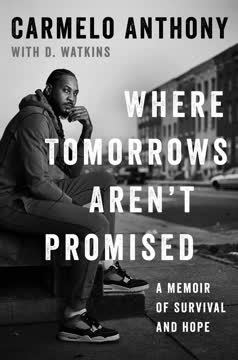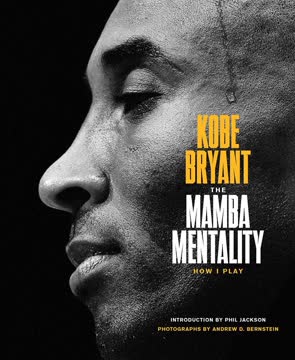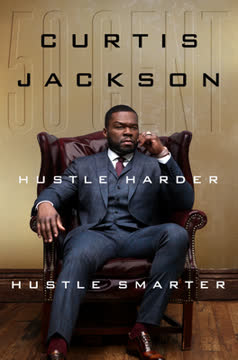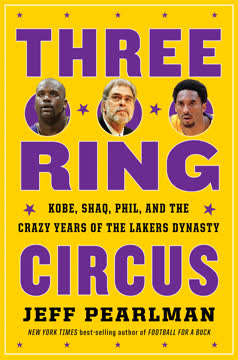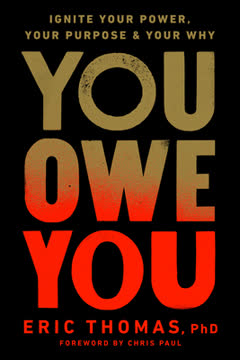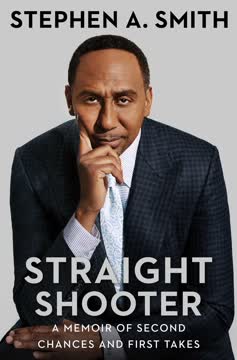Key Takeaways
1. Dreams Deferred: The Weight of Unfulfilled Aspirations
To every child who knows there is more to this life than what people tell them is possible.
Limited expectations. The book opens with a sense of suppressed potential, dedicated to children who sense a world beyond the confines of their circumstances. This sets the stage for a narrative exploring the challenges of breaking free from societal limitations and the internal struggle to believe in a brighter future.
Breaking free. The author's journey is not just about basketball; it's about defying the predetermined paths laid out for him. It's about recognizing the inherent worth and potential within oneself, even when surrounded by voices that attempt to diminish or deny it.
The power of dreams. The dedication serves as a reminder that dreams, however audacious, are essential for survival and progress. It's a call to action for young people to resist the temptation to settle for mediocrity and to strive for something greater, even when the odds seem insurmountable.
2. Apartment 1C: A Sanctuary Amidst the Storm
Apartment 1C was the spot, a hub made up of love, and everybody knew it.
Open-door policy. Apartment 1C represents a haven of love, acceptance, and support within the Red Hook projects. The author's mother's open-door policy created a space where anyone in need could find food, advice, or simply a sense of belonging.
Community hub. The apartment served as a gathering place for a diverse range of individuals, from "killers and gangsters to kids and the elderly." This illustrates the complex social fabric of the projects, where people from all walks of life were interconnected.
Window to the world. The side windows of Apartment 1C provided a glimpse into the world beyond the author's reach, offering a mix of entertainment, education, and harsh realities. These windows became a source of knowledge and inspiration, fueling his curiosity and shaping his understanding of the world.
3. Red Hook's Dichotomy: Beauty Tangled with Danger
There’s a peculiar type of beauty that existed in Red Hook.
Resilience in adversity. Despite the challenges of poverty, racism, and violence, the Black and Brown residents of Red Hook found ways to survive and even thrive. This resilience is a testament to the strength and ingenuity of the community.
Intertwined realities. The author acknowledges the constant presence of danger in his neighborhood, from violence on the basketball court to drug deals and robberies. However, he also emphasizes the beauty and love that existed alongside the chaos.
Family and community. The author's family and community provided a sense of belonging and support, offering lessons in love, humility, and loyalty. These values served as a guiding force throughout his young life, helping him navigate the complexities of his environment.
4. The G.I. Bill's Broken Promise: A Legacy of Inequality
White people took all of that G.I. Bill money and used it as the seeds that grew the suburbs.
Systemic racism. The G.I. Bill, intended to support veterans returning from World War II, was largely denied to African Americans due to discriminatory practices. This denial perpetuated racial inequality and hindered the economic advancement of Black families.
Suburbanization and wealth. White veterans were able to use G.I. Bill benefits to purchase homes in the suburbs, building generational wealth and creating opportunities for their families. Black veterans, on the other hand, were often relegated to public housing projects.
The projects as a solution. The author argues that the projects were offered to Black people as a substitute for the opportunities they were denied through the G.I. Bill. This highlights the systemic nature of racism and its impact on housing and economic mobility.
5. Mary Anthony: A Mother's Unwavering Love and Resilience
Hands down, Mary Anthony was the best mother in Red Hook.
Strength and sacrifice. The author's mother, Mary Anthony, is portrayed as a strong, regal woman who worked tirelessly to provide for her family. She held two jobs, managed household responsibilities, and still found time to expose her children to art, culture, and experiences beyond the neighborhood.
Importance of education. Mary Anthony stressed the importance of education as a means of escaping poverty and creating a better life. She instilled in her children a desire to reach for the stars and never settle for less.
Community mother. Mary Anthony's generosity extended beyond her own family, as she often took in relatives and neighbors in need. Her open-door policy and willingness to help others made her a beloved figure in the Red Hook community.
6. Baltimore's Charm City Facade: A Tale of Two Baltimores
It’s a city split on ideologies, because it’s too South to be North and too North to be South.
Small-town feel. Baltimore is described as a major city with a small-town feel, where "everybody knows everybody." This creates a sense of community but also limits opportunities and reinforces existing social hierarchies.
Racial segregation. The author notes the stark racial segregation in Baltimore, with predominantly Black neighborhoods like Murphy Homes existing alongside wealthier, predominantly white areas like Bolton Hill. This segregation perpetuates inequality and limits social mobility.
Contrasting realities. The author contrasts the experiences of Black residents in Murphy Homes with those of white residents in Bolton Hill, highlighting the disparities in wealth, opportunity, and overall quality of life. This contrast underscores the systemic nature of racism and its impact on the city.
7. Robert C: Finding Solace and Purpose on the Blacktop
Robert C was my outlet.
Community hub. Robert C. Marshall Recreation Center served as a safe haven and source of positive activities for the author and other young people in the neighborhood. It offered opportunities to participate in sports, develop skills, and build relationships.
Basketball as escape. Basketball provided an escape from the violence, drugs, and negativity that plagued the author's neighborhood. It offered a sense of purpose, a way to channel his energy, and a path toward a better future.
Lessons beyond the game. The author learned valuable life lessons at Robert C, including the importance of hard work, discipline, and perseverance. He also developed a sense of community and belonging, finding mentors and role models who helped him navigate the challenges of his environment.
8. Carmelo: Embracing Identity in a World of Conformity
Nobody has it because you are special.
The Tyrone experiment. The author's attempt to change his name to Tyrone Johnson reflects his desire to fit in and avoid the mispronunciations and questions that came with his unique name. This highlights the pressure to conform and the challenges of embracing one's identity in a world that often marginalizes difference.
Rediscovering pride. His mother's reaction to his rejection of his name leads him to reconsider its significance. He realizes that his name connects him to his father and represents a legacy of strength and resilience.
Embracing uniqueness. The author's journey to embrace his name is a metaphor for his overall journey of self-discovery. He learns to value his individuality and to resist the pressure to conform to societal expectations.
9. Filling Voids: The Search for Guidance and Belonging
Yo, Chello, come on. We going to the court.
Brotherly bond. The author's relationship with his cousin Luck is portrayed as a source of guidance, support, and inspiration. Luck served as a role model, teaching him about basketball, street smarts, and how to navigate the complexities of his environment.
Loss and absence. The departure of Luck and his sister Michelle creates a void in the author's life, leaving him feeling isolated and vulnerable. This highlights the importance of family and community in providing a sense of belonging and stability.
Filling the void. The author seeks to fill the void left by Luck's absence by immersing himself in sports, building friendships, and finding new mentors. This demonstrates his resilience and determination to overcome adversity.
10. The Red House: A Haven Amidst the Chaos
We were in the red house made up of painted red bricks that were the color of fruit punch.
A symbol of hope. The red house on Myrtle Avenue represents a fresh start and a symbol of hope for the author and his family. It offers more space, fewer residents, and a sense of stability that was lacking in their previous apartment in Red Hook.
Community connection. The author quickly establishes connections with his new neighbors, forming friendships and finding a sense of belonging in the Baltimore community. This demonstrates his ability to adapt and thrive in new environments.
Michelle's guidance. The author's sister, Michelle, continues to play a significant role in his life, providing guidance, support, and a sense of continuity with his past. Her presence helps him navigate the challenges of his new environment and maintain a connection to his roots.
11. The Weight of Loss: Navigating Grief and Depression
I was depressed at a time when depression wasn’t a topic, at least not in my community.
Unacknowledged pain. The author grapples with the deaths of his stepdad and cousin Luck, experiencing a deep sense of grief and depression. However, he struggles to express his emotions due to the cultural norms of his community, which discourage vulnerability and prioritize strength.
Coping mechanisms. The author turns to sports, music, and friendships as coping mechanisms, seeking to distract himself from the pain and find moments of joy and connection. These outlets provide temporary relief but do not fully address the underlying issues.
The search for understanding. The author seeks to understand the meaning of loss and the nature of his own pain, questioning his beliefs and searching for answers in his environment. This demonstrates his resilience and his determination to find meaning in the face of adversity.
12. The Price of Success: Sacrifices, Betrayal, and Redemption
Always be patient.
The lure of the NBA. As the author's basketball skills develop, he faces increasing pressure to pursue a professional career. This creates a conflict between his desire to fulfill his dreams and his loyalty to his family and community.
Betrayal and loss. The author experiences betrayal and loss as he navigates the world of high-stakes basketball, learning that not everyone has his best interests at heart. This forces him to confront the darker side of success and the sacrifices required to achieve it.
Redemption and purpose. Despite the challenges he faces, the author remains committed to his goals and determined to use his platform to make a positive impact. He recognizes the importance of staying true to himself and giving back to his community, finding redemption and purpose in his journey.
Last updated:
FAQ
1. What is "Where Tomorrows Aren't Promised" by Carmelo Anthony about?
- Memoir of Survival and Hope: The book is Carmelo Anthony’s memoir, chronicling his journey from the housing projects of Red Hook, Brooklyn, and Baltimore to becoming an NBA All-Star.
- Explores Poverty and Violence: It delves into the harsh realities of growing up amid poverty, racism, drugs, and violence, and how these shaped his worldview and ambitions.
- Focus on Family and Community: Anthony shares intimate stories about his family, mentors, and the communities that influenced him, highlighting both the struggles and the support systems that helped him survive.
- Beyond Basketball: While basketball is a central theme, the memoir is more about personal growth, resilience, and the search for hope in environments where the future is never guaranteed.
2. Why should I read "Where Tomorrows Aren't Promised" by Carmelo Anthony?
- Raw and Honest Storytelling: Anthony offers an unfiltered look at his upbringing, providing insights into the challenges faced by many young people in marginalized communities.
- Inspiration and Motivation: The memoir is a testament to overcoming adversity, making it a powerful read for anyone seeking motivation or understanding of resilience.
- Unique Perspective: Readers gain a deeper understanding of the intersection between sports, race, poverty, and opportunity in America, told from the perspective of a major sports figure.
- Broader Social Commentary: The book goes beyond Anthony’s personal story, touching on systemic issues like racism, the failures of the education system, and generational trauma.
3. What are the key takeaways from "Where Tomorrows Aren't Promised"?
- Resilience is Essential: Surviving and thriving in difficult circumstances requires mental toughness, adaptability, and the ability to find hope even when tomorrow isn’t promised.
- Community and Family Matter: Support from family, friends, and mentors can be the difference between falling victim to your environment and rising above it.
- Systemic Barriers Exist: The memoir highlights how racism, poverty, and institutional failures create obstacles for Black and Brown youth, but also how individuals can navigate and challenge these systems.
- Success is Not Linear: Anthony’s journey was filled with setbacks, losses, and moments of doubt, showing that success often comes from perseverance through hardship.
4. How does Carmelo Anthony describe his childhood in Red Hook and Baltimore in "Where Tomorrows Aren't Promised"?
- Red Hook: Beauty and Danger: Anthony describes Red Hook as a place of both community warmth and constant threat, where beauty and violence were inseparable.
- Baltimore: New Challenges: Moving to Baltimore introduced new dangers and required him to adapt quickly, but also offered fresh opportunities and friendships.
- Family as a Lifeline: His mother, siblings, and extended family provided stability and love, even as they struggled with poverty and loss.
- Early Lessons: The streets, the projects, and the people around him taught him crucial lessons about loyalty, survival, and the importance of staying alert.
5. What role did family and mentors play in Carmelo Anthony’s life according to "Where Tomorrows Aren't Promised"?
- Mother’s Strength: His mother, Mary Anthony, is portrayed as the backbone of the family, working multiple jobs and instilling values of independence and education.
- Siblings and Cousins: His siblings and cousin Luck were both role models and protectors, teaching him about toughness, loyalty, and street smarts.
- Mentors and Coaches: Coaches like Mr. Wise, Jim Black, and Bay provided guidance, discipline, and opportunities, helping him channel his energy into sports.
- Community Elders: Figures like Big Hand Wood in Baltimore acted as surrogate father figures, offering advice, protection, and real-world wisdom.
6. How does "Where Tomorrows Aren't Promised" by Carmelo Anthony address issues of race, poverty, and systemic injustice?
- Historical Context: Anthony explains how policies like the G.I. Bill and housing projects were used to segregate and disadvantage Black and Brown communities.
- Personal Experiences: He shares firsthand accounts of racism, police brutality, and the daily struggles of living in under-resourced neighborhoods.
- Generational Impact: The book discusses how systemic barriers affect not just individuals but entire families and communities across generations.
- Call for Change: Anthony’s story is both a critique of these injustices and a call to recognize and address the root causes of inequality.
7. What are the most significant challenges Carmelo Anthony faced on his path to the NBA, as described in "Where Tomorrows Aren't Promised"?
- Loss and Trauma: He endured the deaths of close family members and friends, including his cousin Luck and mentor Wood, as well as the absence of his father.
- Violence and Crime: Growing up in environments plagued by drugs, shootings, and instability, he constantly had to navigate danger.
- Educational Barriers: Anthony struggled with school transitions, academic expectations, and cultural clashes, especially at Towson Catholic and Oak Hill.
- Self-Doubt and Pressure: He faced moments of depression, self-doubt, and the immense pressure of being seen as a ticket out for his family and community.
8. How did basketball serve as a means of survival and hope for Carmelo Anthony in "Where Tomorrows Aren't Promised"?
- Safe Haven: Basketball provided a refuge from the chaos and violence of his surroundings, keeping him focused and out of trouble.
- Pathway to Opportunity: Excelling at basketball opened doors to better schools, travel, and eventually a college scholarship and NBA career.
- Community and Identity: The sport helped him build relationships, earn respect, and develop a sense of identity and purpose.
- Coping Mechanism: Basketball was a way to channel pain, anger, and loss into something positive and productive.
9. What specific advice or life lessons does Carmelo Anthony share in "Where Tomorrows Aren't Promised"?
- Stay Alert and Adapt: Always be aware of your surroundings and be ready to adapt to new challenges, as danger can come from anywhere.
- Value Loyalty and Integrity: Loyalty to family, friends, and self is paramount, but it’s also important to recognize when to move on for your own growth.
- Don’t Let Others Define You: Anthony emphasizes the importance of self-worth and not letting others’ expectations or prejudices dictate your path.
- Embrace Vulnerability: While his environment discouraged showing emotion, he acknowledges the importance of confronting pain and seeking healing.
10. How does Carmelo Anthony portray the importance of education and mentorship in "Where Tomorrows Aren't Promised"?
- Education as Escape: His mother’s insistence on education was a key factor in keeping him focused and providing alternatives to street life.
- Mentorship’s Lasting Impact: Coaches and mentors not only taught him sports skills but also life lessons about discipline, teamwork, and resilience.
- Navigating Institutions: Anthony discusses the challenges of fitting into predominantly white institutions and the need for supportive mentors in those spaces.
- Learning Beyond the Classroom: He highlights the value of learning from experience, community elders, and self-education, not just formal schooling.
11. What are some of the most powerful quotes from "Where Tomorrows Aren't Promised" and what do they mean?
- “A place where danger was tangled up with beauty, and you couldn’t untie one from the other.” – Reflects the complexity of growing up in Red Hook, where love and threat coexisted.
- “Resilience is a muscle you build by surviving.” – Emphasizes that strength comes from enduring and overcoming hardship.
- “I never allowed myself to be lost in a dream that could be easily snatched away.” – Shows his guarded optimism and the reality of having hopes repeatedly dashed.
- “If you are not going fight every single day, boy, you going to cry every single day.” – His mother’s tough love, teaching him to stand up for himself in a harsh world.
12. How does "Where Tomorrows Aren't Promised" by Carmelo Anthony redefine the idea of success and the American Dream?
- Success as Survival: For Anthony, making it out alive and intact from Red Hook and Baltimore was already a form of success, regardless of fame or wealth.
- Redefining the Dream: The book challenges the traditional American Dream narrative, showing how systemic barriers make it inaccessible for many.
- Giving Back: True success, in Anthony’s view, involves using one’s platform and resources to uplift others and fight for justice.
- Ongoing Journey: The memoir ends with the understanding that success is not a final destination but a continuous process of growth, healing, and giving hope to others.
Review Summary
Where Tomorrows Aren't Promised receives mostly positive reviews, with readers praising Anthony's storytelling and vulnerability. Many appreciate the focus on his early life and struggles growing up in tough neighborhoods. The book's ending at the NBA draft surprises some, but most find it fitting. Readers commend Anthony's resilience, positive outlook, and the impact of his support system. Some criticize the writing style or wish for more NBA content, but overall, the memoir is seen as inspiring and insightful.
Similar Books
Download PDF
Download EPUB
.epub digital book format is ideal for reading ebooks on phones, tablets, and e-readers.
